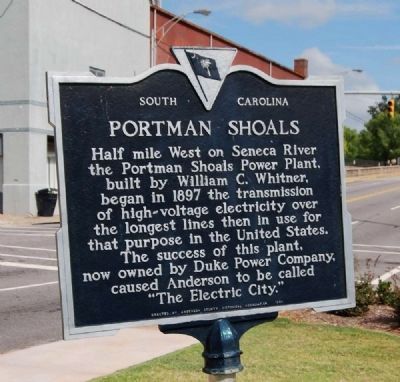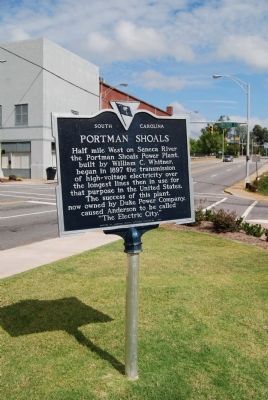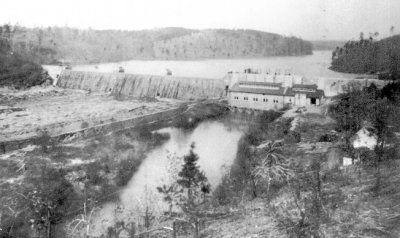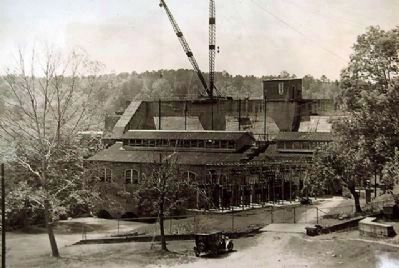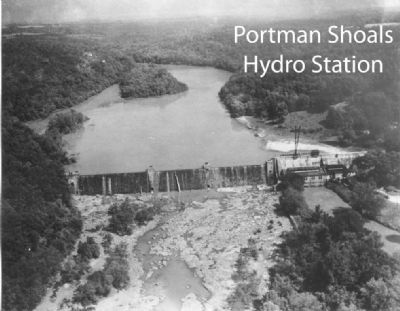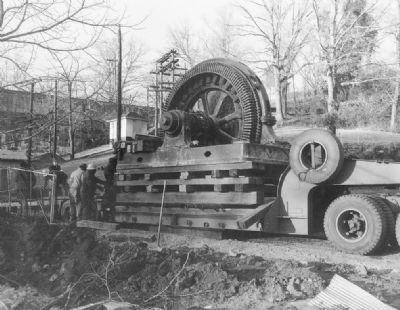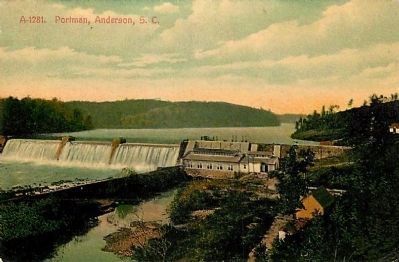Anderson in Anderson County, South Carolina — The American South (South Atlantic)
Portman Shoals
the Portman Shoals Power Plant,
built by William C. Whitner,
began in 1897 the transmission
of high-voltage electricity over
the longest lines then in use for
that purpose in the United States.
The success of this plant,
now owned by Duke Power Company,
caused Anderson to be called
"The Electric City."
Erected 1956 by Anderson County Historical Association. (Marker Number 4-1.)
Topics and series. This historical marker is listed in these topic lists: Industry & Commerce • Notable Events. In addition, it is included in the South Carolina, Anderson County Historical Association/Society series list. A significant historical year for this entry is 1897.
Location. 34° 30.224′ N, 82° 38.915′ W. Marker is in Anderson, South Carolina, in Anderson County. Marker is at the intersection of North McDuffie Street and Whitner Street, on the right when traveling south on North McDuffie Street. Marker is located near Generator Park. Portman Shoals was located at the junction of the Seneca and Tugaloo Rivers. Touch for map. Marker is in this post office area: Anderson SC 29621, United States of America. Touch for directions.
Other nearby markers. At least 10 other markers are within walking distance of this marker. Portman Dam and Power Plant (here, next to this marker); G.F. Tolly Building -- c. 1910 (a few steps from this marker); Masonic Temple -- 1889 (about 400 feet away, measured in a direct line); Fant's Book Store -- 1851 (about 400 feet away); Blue Ridge Railroad Passenger Station -- c. 1913 (about 500 feet away); The Four Way Test (about 500 feet away); William Church Whitner (about 500 feet away); Anderson County Court House -- 1898 (about 500 feet away); Beyond Commerce: Building a Legacy of Hard Work (about 500 feet away); Anderson: "The Electric City" (about 500 feet away). Touch for a list and map of all markers in Anderson.
Regarding Portman Shoals. Given the directions provided on the marker, it is probably that this intersection was not its original location. A second marker, also entitled Portman Shoals, was erected near the Seneca River.
Related marker. Click here for another marker that is related to this marker. A second marker, also entitled Portman Shoals, was erected near the Seneca River.
Also see . . .
1. City of Anderson, SC. Official website for the City of Anderson, SC. (Submitted on November 28, 2011, by Brian Scott of Anderson, South Carolina.)
2. Anderson, South Carolina. Anderson is a city in and the county seat of Anderson County, South Carolina, United States. (Submitted on November 28, 2011, by Brian Scott of Anderson, South Carolina.)
3. Seneca River. The Seneca River is created by the confluence of the Keowee River and the Little River in northern South Carolina, just down river from Lake Keowee. (Submitted on June 14, 2009, by Brian Scott of Anderson, South Carolina.)
Additional commentary.
1. The Portman Family
This land was once owned by John Portman, Langdon Cheves, and Samuel Earle. Christopher Portman, sailed from England, October 11, 1679, on the ship Endeavor for Carolina. He is listed among the Colonial Patriots in the year 1700. John Portman, who later owned much land on Seneca River, served in the Cherokee Expedition 1759-1760. His grandson, John, and his son-in-law, Lieutenant William Grant, Jr., fought in the South Carolina Militia during the Revolutionary War. So, Portman Shoals was named after the Portmans who settled there.
— Submitted November 16, 2008, by Brian Scott of Anderson, South Carolina.
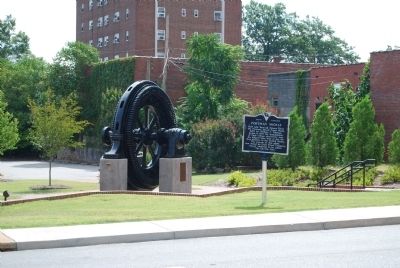
Photographed By Brian Scott, August 23, 2008
3. Generator Park and Marker
The generator shown was saved from the Portman Dam before it was covered by the flooding of the Seneca River in the creation of Lake Hartwell. For years, the generator was stored in one of the city's wastewater treatment plants and later at the city recreation center.
2. Anderson's Electric Plant - Anderson Intelligencer, December 15, 1897
and Power Company – The Plant at
Portman Shoals Complete – A Big
Success – Its Cheapness and
Convenience
Very few people outside Of Anderson have any idea what has recently been accomplished in the development and advancement of electrical energy in this city by the Anderson Water, Light and Power Company, and the influence this almost unlimited power will have upon the future history of this entire section. Cheapness of production is one of the stern demands of the times, particularly in manufacturing industries, and cheapness of power to propel the machinery in the great desideratum.
At Portman Shoals, on the Seneca River, nine miles from Anderson, an electric plant has been completed which is designed to generate an electrical energy of 5,000 horse power, as occasion may require, and the plant is now generating and successfully transmitting to this city 2,000 electrical horse power, the greater portion of which is distributed among important mechanical industries and used in lighting the oily. The dam and power house of this plant are as substantial as granite and good masonry can make them, and the electrical apparatus is of the latest improved designs,
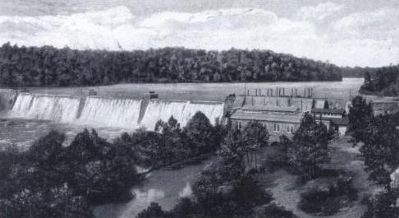
circa 1920
4. Portman Shoals Power Plant, Seneca River
W.C. Whitner conceived the idea of the long distance transmission of electric power in 1894. First a small plant was established at High Shoals on the Rocky River six miles from Anderson. It transmitted 200 electric horsepower from 5,000-volt generators. Then the Portman Shoals Power Plant on the Seneca River, a 10-mile distance, was built by the Anderson Light & Power Company. Construction began in 1896. It used Stanley Electric Company's 10,000-volt generators. The Portman dam, swept away in December of 1901, was rebuilt and returned to service in September 1902. The plant caused Anderson to be called the "Electric City." (Source: South Carolina Postcards, Vol. IX: Anderson County by Howard Woody (2003), pg 79.)
Only two of these flumes are being used at present, the others being held in reserve to be put in motion as the power is contracted for by manufacturing industries.
Of the 2,000 electric horse power now being generated and transmitted, the Anderson Cotton Mills take about 1400 horse power, a considerable quantity is used in operating the water works, driving large power pumps, a considerable quantity distributed to various other smaller industries, and as much as is necessary used to run the arc and incandescent lights of the city.
The cost of this electrical power as compared with steam is at least 25 per cent, cheaper, and when it is considered that it can be delivered at any place designated by the manufacturer, enabling him to locate his industry with reference to railroad facilities, taxes, healthful locality and the like, the advantages of this wonderful power over steam must address itself to every thinking manufacturer.
Anderson has the power. The plant is complete. The enterprise is a success. Thirty-six thousand spindles and twelve hundred looms are being operated here in the Anderson Cotton Mills by this electric energy, as well as many smaller industries. Cheapness and convenience is the very essence of this enterprise, and Anderson now wants to see manufacturing industries spring up on every side. There is no city in the South which can offer greater advantages. Situated at the foot of the Blue Ridge Mountains, in the famous Piedmont region, with pure air and water, delightful climate the year round, and with natural advantages seldom equaled, Anderson offers all that the most exacting could demand.
That the development of this great electrical power plant and the natural advantages offered by Anderson must eventually surround this city with manufacturing industries, there can be no doubt, and we confidently believe that in less than a decade the population of this city will double. But we would remind those of our citizens who have been successful in their business enterprises that the prompt and rapid growth of these new industries will depend largely, very largely, upon the encouragement and impetus they extend to them. By this we mean not such encouragement us ends with words, but substantial encouragement by the investment of dollars, every new industry started will benefit every citizen. They will furnish work for our people and prosperity and happiness will most certainly follow.
Before closing this article a few words concerning Mr. W.C. Whitner, the moving spirit in the electrical development of this city, cannot be inappropriate. He was born and raised in our midst, and his family is one of the most prominent In the State. He was born Sept. 3, 1864, and, as will be seen, is still a young man. It was he who took the initiative step and laid the foundation for this great enterprise. In1890 he established the Anderson Water Works and lit the city with 750 incandescent lights, generating the electric current by steam poor. In 1894 he conceived the idea to utilize some neighboring water power to operate the electric light plant and the water works. Mr. Whitner was convinced at the time that the transmission of electric power was a success, and was in favor of purchasing Portman Shoals on Seneca river, 10 miles distant, and developing it. But his associates did not agree with him, nor was the Anderson Cotton Mill ready at that time to make a contract for electrical power to operate the mill, a condition which was very necessary in so large an undertaking. Mr. Whitner, however, felt sure of his position, that the development of Portman Shoals was the proper step, and commenced to buy such parts of this shoal as he could secure as a private investment. In the meantime his company signified their willingness to try the long distance transmission of electric power on a small scale, and for this purpose authorized Mr. Whitner to lease High Shoals on Rocky River, 6 miles distant, and with an investment of $25,000, a part of which was Anderson money, developed and successfully transmitted 200 electrical horsepower. The incandescent lights were increased to 2,000 and 70 arc lights were put in, the large water pumps at the water works plant were operated by this power, and the balance was distributed to various smaller industries in the city which had been induced to put in motors.
The cheapness end convenience of electrical power soon became evident to our people. Investigation showed it a necessity. The Anderson Cotton Mills, through Mr. J.A. Brock, the president, signified their willingness to use electric power instead of steam. Another industry did the same and the company undertook the enterprise, determining to develop the water power at Portman Shoals.
A meeting was called and Anderson subscribed to $50,000 of the bonds proposed to be issued. The company was reorganized as the Anderson Water, Light and Power Company, with Dr. S.M. Orr as president and quite a number of our leading businessmen as directors. In a short time, through the efforts of Dr. Orr, Mr. W.J. Roddy, and W.C. Whitner, $100,000 was raised outside the city, and work begun with the above results. Just here it is not inappropriate to say that Dr. Orr showed his faith in this enterprise from the very beginning, doing everything in his power to convince our people that the development of Portman Shoals was what was really needed to give Anderson a new start and make it a great manufacturing center. The interest he manifested, and the work he did among our business men certainly played an important part in bringing about the success which has attended this great enterprise.
Dr. Orr was ably assisted by Mr. R.S. Hill, representing the Farmers and Merchants' Hank, and Mr. B.F. Mauldin, representing the Bank of Anderson, who were appointed a committee to solicit the subscription of $50,000 to the bonds proposed to be issued and which the company determined to raise from the people of Anderson before soliciting outside subscription. The work accomplished by these gentlemen was remarkable, and had they been working for their respective banks, or for any individual enterprise, they could not have displayed greater energy. The $50,000 was subscribed in an incredibly short time, which clearly indicated that the enterprise was promptly endorsed by the business men of Anderson, and this prompt endorsement had much to do with the success of floating the $100,000 of bonds outside of Anderson.
Mr. Whitner is justly entitled to be called the pioneer in the use of high voltage machines and in long distance transmission.
The plant established at High Shoals was the first long distance transmission power plant established in the South, and the electric generator then used was the first alternating current machine in the world to be built and operated for an initial voltage of 5,000 volts. It was considered impracticable to operate this type of dynamo at so high a voltage. The alternating current was comparatively new and high voltage was an experiment and considered dangerous. Running the machines at low voltage and using step-up transformers to obtain the high voltage required was considered the only practicable method, and when Mr. Whitner visited the electric manufacturing companies with a view of having this machine built, his views were regarded by many as rather previous. The Stanley Electric Manufacturing Company, of Pittsfield, Mass., fully agreed with Mr. Whitner, however, and encouraged him to use this voltage. They built the machines, and since that time the building of generators at high voltage has been adopted by all the manufacturers. When the plant at Portman Shoals was established Mr. Whitner decided to use generators giving 11,000 voltage, and they are now being operated successfully and with perfect safety, and this is the only plant in the world where alternating current generators are operated with so high a voltage as 11,000 direct on the generators and switch boards.
This is a magnificent electrical plant. There is none bolter in the world. The power is abundant, convenient, clean, and cheap, and manufacturers throughout the country now using steam power or establishing new manufacturing industries should investigate the advantages and inducements held out to them by the City of Anderson and the Anderson Water, Light, and Power Company.
By substituting electrical power for steam power the Anderson Cotton Mills make a saving of $10,000 per annum, which is a considerable dividend within itself and clearly indicates the advantages he development of this electric power enterprise offers to manufacturing industries. It has been necessary heretofore in the building of cotton mills in our midst for our people to offer special inducement, but with a showing like this – where $10,000 is actually being saved annually by the Anderson Cotton Mills – inducement is permanent and should be of itself sufficient.
— Submitted August 31, 2012, by Brian Scott of Anderson, South Carolina.
Credits. This page was last revised on October 14, 2020. It was originally submitted on August 24, 2008, by Brian Scott of Anderson, South Carolina. This page has been viewed 3,440 times since then and 114 times this year. Photos: 1. submitted on June 14, 2009, by Brian Scott of Anderson, South Carolina. 2, 3. submitted on August 24, 2008, by Brian Scott of Anderson, South Carolina. 4. submitted on January 2, 2009, by Brian Scott of Anderson, South Carolina. 5, 6. submitted on November 28, 2011, by Brian Scott of Anderson, South Carolina. 7, 8, 9. submitted on January 16, 2012, by Brian Scott of Anderson, South Carolina. • Kevin W. was the editor who published this page.
